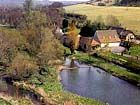Sharp rise of repossessions predicted
Mortgage lenders are expecting next year will see a rise in borrowers slipping behind on their mortgage payments


The Council of Mortgage Lenders (CML) said the number of households more than three months behind with their repayments would reach 500,000 in 2009, more than doubling the figure for this year.
The CML said 2009 would be "very tough" because the recession would lead to more unemployment and higher numbers of repossessions among borrowers.
'The economic recession means unemployment is rising sharply, and this will inevitably impact on the number of households facing mortgage arrears,' it said.
The CML's latest figures show that mortgage lending in November had dropped by a half of what it was in the same month last year, falling to just under £15 billion. House price forecasts under these circumstances are regarded as futile, according to the CML.
Sign up for the Country Life Newsletter
Exquisite houses, the beauty of Nature, and how to get the most from your life, straight to your inbox.
Country Life is unlike any other magazine: the only glossy weekly on the newsstand and the only magazine that has been guest-edited by HRH The King not once, but twice. It is a celebration of modern rural life and all its diverse joys and pleasures — that was first published in Queen Victoria's Diamond Jubilee year. Our eclectic mixture of witty and informative content — from the most up-to-date property news and commentary and a coveted glimpse inside some of the UK's best houses and gardens, to gardening, the arts and interior design, written by experts in their field — still cannot be found in print or online, anywhere else.
-
 A well-connected rural playground with 23 acres on the edge of the South Downs National Park
A well-connected rural playground with 23 acres on the edge of the South Downs National ParkOld House Farm is an impressive family home with a wealth of amenities that would inspire any rural passion.
By Arabella Youens Published
-
 The UK gets its first ‘European stork village’ — and it's in West Sussex
The UK gets its first ‘European stork village’ — and it's in West SussexAlthough the mortality rate among white storks can be up to 90%, the future looks rosy for breeding pairs in southern England.
By Rosie Paterson Published

